Exploring Butcher Block Wood in Furniture Design
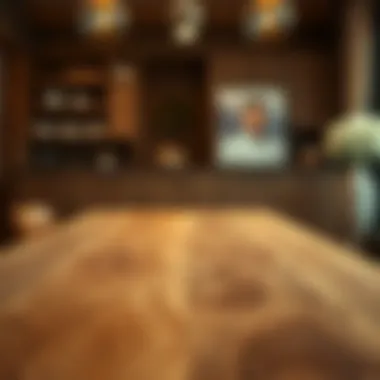
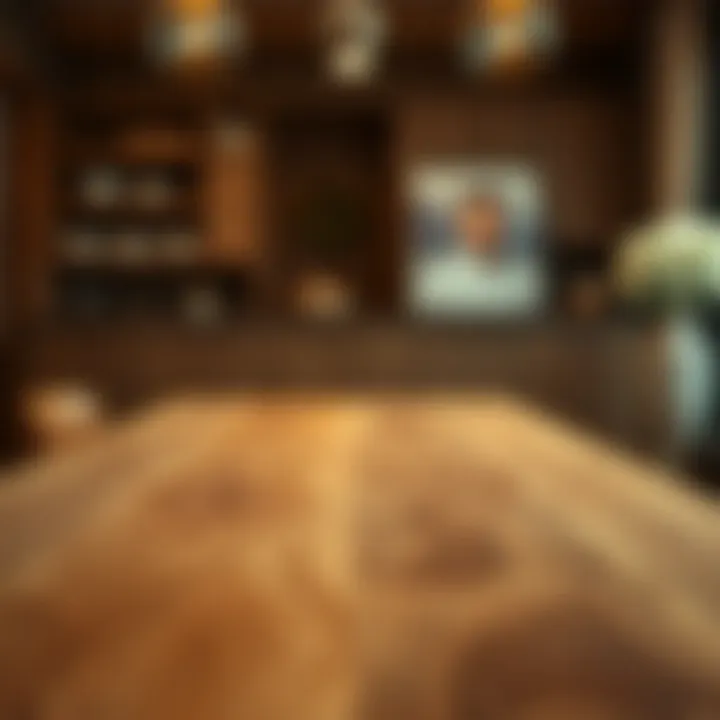
Intro
In the world of furniture design, the choice of materials can significantly influence both aesthetic appeal and functionality. Among these options, butcher block wood stands out as a unique contender. Not only is its history rich and varied, but its applications stretch far beyond the conventional kitchen countertop. This article explores the multifaceted aspects of butcher block wood, shedding light on its historical significance, manufacturing processes, types of wood used, advantages and disadvantages, as well as maintenance considerations. Furthermore, we will delve into its environmental implications and the innovative design trends that have emerged around it. By combining practical information with aesthetic insights, we aspire to furnish furniture enthusiasts, designers, and homeowners alike with a nuanced understanding of this versatile material.
Furniture Design Trends
Current Styles and Aesthetics
Butcher block wood has made a remarkable resurgence in various furniture styles, appealing to homeowners and designers who seek a touch of warmth and rustic charm within modern interiors. With its distinctive grain patterns and robust texture, butcher block often finds its place in both contemporary and traditional settings. From farmhouse tables that evoke nostalgia to minimalist kitchen islands that emphasize functionality, the adaptability of this wood is truly impressive.
In current design trends, butcher block is often paired with sleek, industrial elements like metal frames and matte finishes, creating a striking contrast that adds depth to the overall aesthetic. Its presence in open-concept living spaces signifies a fondness for natural materials, promoting a sense of connection between the indoors and the environment outside. Furthermore, the rise of sustainable design has led many to appreciate not only the beauty of butcher block but also its eco-friendly sourcing practices.
Color Palettes and Materials
When it comes to color palettes, butcher block wood has the versatility to complement an array of tones. The natural rich hues of woods like maple, walnut, and cherry can be enhanced through various finishing techniques, allowing for a spectrum of shades from light to dark. For example, a warm-toned maple butcher block pairs beautifully with cool blues and greens, making it a favorite in modern kitchens. On the other hand, darker woods like walnut can add a touch of elegance when juxtaposed with lighter fixtures and decor.
In terms of materials, combining butcher block with glass or ceramic elements can lead to highly personalized pieces. Moreover, the contrast of smooth surfaces against the textured finish of butcher block can elevate the visual interest. Adding metal accents, such as handles or legs, can create a more industrial vibe, while soft, organic textiles bring in a sense of coziness.
"The use of butcher block wood in modern design emphasizes both beauty and functionality, encouraging a harmonious lifestyle with nature."
Ultimately, the beauty of butcher block wood lies in its ability to transcend styles, catering to a wide range of design preferences. Homeowners and designers alike can leverage its robust nature, making it an excellent choice for innovative furniture pieces that stand the test of time.
Buying Guides
Essential Considerations When Purchasing
Selecting the right butcher block wood for your furniture needs a careful approach. Here are some essential considerations to keep in mind when making your puchase:
- Wood Type: Different wood species offer varying hardness, color, and grain patterns. Maple is often favored for countertops, whereas walnut lends elegance to tables.
- Thickness: Consider the intended use. Thicker slabs offer greater durability, while thinner pieces can be used for more decorative purposes.
- Finish: A food-safe finish is crucial if it’s intended for kitchen use. Look out for mineral oil or beeswax finishes, which provide a natural look and protection.
- Source: A reputable source ensures quality and sustainability. Look for certified wood dealers who prioritize eco-friendly practices.
Top Recommendations for Different Budgets
Depending on your budget, there are compelling options available in the market.
- Affordable Choices: Look for places like IKEA or home improvement stores that provide good-quality butcher block surfaces without breaking the bank.
- Mid-Range Recommendations: Brands such as John Boos or Williams Sonoma offer a range of butcher block products that balance quality with affordability.
- High-End Selections: If you’re in the market for luxury items, brands like Charles & Marie provide exquisite handcrafted butcher block pieces that can elevate any space.
For more information on styles and materials, you can visit Wikipedia or browse articles on Britannica. Stay tuned as we navigate further into the complexities and endless possibilities butcher block wood offers in furniture design.
Understanding Butcher Block Wood
To truly appreciate butcher block wood in furniture design, one must grasp what makes this material stand out among the rest. It's not just another wooden surface; it carries a weight of tradition, craftsmanship, and versatility that's hard to come by. When considered for furniture, butcher block wood encompasses a blend of functionality and aesthetic quality that appeals to a wide range of homeowners, designers, and DIY enthusiasts. This section dives into the essence of butcher block wood and sets the stage for further exploration of its attributes and history.
Definition and Characteristics
Butcher block wood refers to a durable and robust surface commonly crafted from hardwoods like maple, walnut, or cherry. Characteristically, this material is formed by gluing together strips of wood, which can be oriented either edgewise or flatwise. The strength and resilience of butcher block wood make it an exceptional choice not only for kitchen countertops, but also for crafting exquisite pieces of furniture.
Typically, butcher block surfaces feature a beautiful array of rich colors and patterns, from the creamy beige of maple to the deep chocolate tones of walnut. This variety adds a unique touch to any furniture piece, ensuring that no two pieces are ever identical. Homeowners looking for a rustic or modern aesthetic find that butcher block wood fits seamlessly into either design scheme.
Some key characteristics include:
- Durability: Butcher block wood surfaces are resistant to scratching and chipping, standing the test of daily use.
- Versatility: Whether used in tables, shelving, or kitchen islands, its utility knows no bounds.
- Natural Beauty: Each wooden piece showcases its unique grain pattern, contributing to its overall charm.
Historical Context
Butcher block wood has a storied history that extends well beyond its current trendiness. Originating from traditional kitchens, butcher blocks were initially created as sturdy surfaces for preparing meat. They evolved alongside advancements in woodworking techniques and the increased availability of various tree species. Interestingly, in the 19th century, butcher blocks were often seen as a symbol of wealth and status in households, showcasing the owner's commitment to quality materials.
As society progressed, the utility of butcher block wood expanded, making its way into furniture design as artisans began to recognize its lasting appeal. The craftsmanship associated with creating butcher block furniture became revered, with skilled woodworkers taking great care to select the grain, color, and finish that would enhance each piece. Homeowners of the 20th century began to appreciate not only its resistance to wear and tear but also the aesthetic warmth it brought to their homes.
"In a world increasingly filled with synthetic materials, the allure of butcher block wood lies in its authenticity and timelessness."
The resurgence of interest in natural materials and sustainable design practices in the 21st century has further solidified butcher block wood's place in contemporary furniture. Today, the material signifies a blend of tradition and modern design — highly valued by discerning eyes that appreciate both form and function.
Types of Butcher Block Wood
When it comes to furniture design, the type of wood used can significantly impact both aesthetics and functionality. Butcher block wood, favored for its durability and visual appeal, comes in a variety of forms—each with its unique traits and benefits. Understanding the different types of butcher block wood is essential for making informed decisions that align with design preferences and practical needs. This section will delve into the distinctions between hardwoods and softwoods, as well as the grading of butcher block wood, which ultimately affects the quality and usability of the material.
Hardwoods vs. Softwoods
In the realm of butcher block wood, you'll find yourself weighing the benefits of hardwoods against softwoods. Each category has its unique charm and suitability for different furniture applications.
Maple

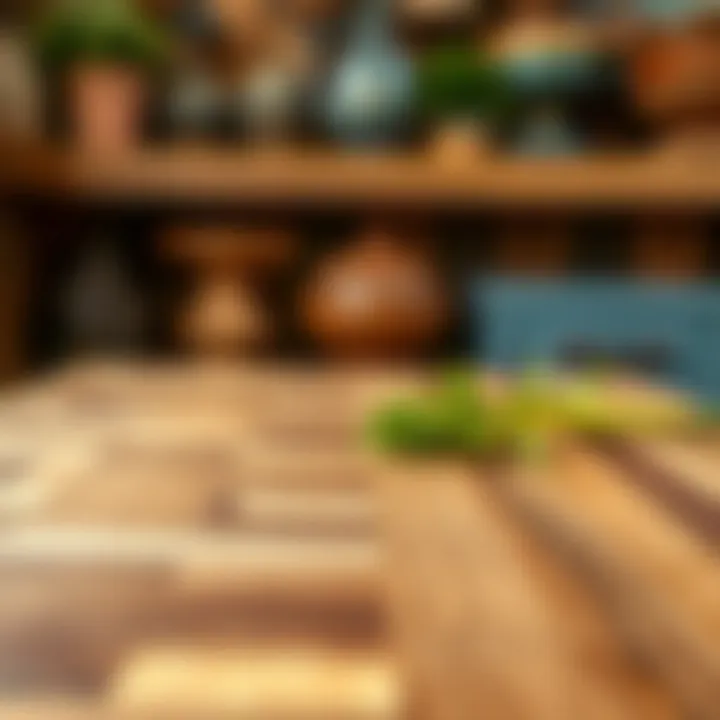
Maple stands out in the butcher block world for its density and strength. It's often considered the go-to wood for kitchen surfaces and countertops due to its resilience against cuts and scratches. This wood has a pale hue that can brighten a space, making it a popular choice for minimalist designs. Its fine, even grain also provides a refined look, appealing to those who cherish simplicity and elegance.
However, maple has a tendency to blotch when stained, which could limit color options for those looking to customize the shade. On the flip side, it offers a smooth surface that is less likely to harbor bacteria, an important aspect for food preparation areas.
Walnut
Walnut is a luxurious choice that’s known for its rich, warm tones and striking grain patterns. Its dark, deep colors provide a dramatic contrast to lighter cabinetry and decor, often resulting in a statement piece in dining areas or desks. Walnut’s inherent stability makes it less prone to warping, adding to its longevity in furniture design.
What sets walnut apart are its unique color variations; no two pieces are alike. While this may be seen as a strength, it can also complicate some design schemes if uniformity is desired. Nonetheless, the benefits of aesthetic appeal and durability often outweigh such concerns for discerning designers and homeowners.
Cherry
Cherry wood is known for its beautiful reddish-brown hue that deepens with age, offering a timeless quality to furniture. Its smooth texture makes it a delight to the touch, and it’s particularly favored for high-end cabinetry and fine furniture. The subtle grain and ability to take on finishes well make it adaptable to a range of styles, from traditional to contemporary.
The downside is that cherry can be more expensive than other woods, which could pose a challenge for budget-conscious projects. Furthermore, its softness makes it more vulnerable to dents, which might require more careful treatment during use.
Bamboo
Bamboo, a grass rather than a traditional wood, has quickly gained popularity in eco-friendly furniture designs. Its rapid growth rates and renewability make it an attractive option for those concerned with sustainability. This material is not only durable but is also lightweight, which adds versatility to its applications.
As a unique feature, bamboo's structure can be compressed and laminated to create stunning visual patterns that mimic traditional wood grains. However, it can be sensitive to humidity, which may lead to warping if not properly cared for. Generally, bamboo presents an attractive choice that marries style with ecological responsibility.
Grades of Butcher Block
When deciding on butcher block wood, understanding the grades is crucial. The quality and overall performance of the butcher block often hinge on its grade classification, which can significantly impact your design decisions and project outcomes.
Commercial Grade
Commercial grade butcher block serves as a reliable option for heavy-use environments, like restaurants and cafes. It’s designed to withstand rigorous activity, which makes it a top pick for furniture that sees a lot of traffic.
A common characteristic is the uniform appearance, as this grade prioritizes functionality over aesthetics. While this grade is robust, it might lack the visual appeal of higher classifications, often seen as too plain for upscale home applications.
Select Grade
Select grade butcher block wood strikes a balance between aesthetics and practicality. It combines both durability and visual charm, making it suitable for kitchen islands or home tables that are both functional and stylish. The wood is typically free from large knots while still maintaining natural features that add character.
The consistency in appearance without completely forsaking grain variation makes it a popular choice for many designers. However, it comes at a higher price point than commercial grade, which may be a consideration for budget-conscious individuals.
Premium Grade
Premium grade butcher block wood exemplifies the peak of quality, often featuring the most exquisite grains and colors. It is ideal for high-end furniture and interior designs where luxury is paramount. This wood is hand-selected for its enhanced beauty and stability, ensuring that the finished product is nothing short of stunning.
With a premium grade, you get the assurance of durability and an aesthetic that can serve as a focal point in any space. That said, the cost is considerably higher, which means it's important to weigh investment against desired outcomes when selecting this option.
Ultimately, understanding the types and grades of butcher block wood is key to making informed choices that enhance both functionality and aesthetic appeal in furniture design.
Manufacturing Butcher Block Wood
The manufacturing process of butcher block wood is a pivotal aspect of understanding how this material is both crafted and utilized in furniture design. This section delves into the intricate steps involved in creating butcher block surfaces, highlighting why these processes are critical not just for aesthetics but also for functionality and longevity. Knowing the ins and outs of manufacturing allows homeowners and designers to make informed choices about how to incorporate butcher block wood into their spaces, ensuring that they reap the full benefits of this remarkable material.
Sourcing Raw Materials
Sourcing raw materials is the foundation of any strong manufacturing process. When it comes to butcher block wood, the selection of the right type of wood is essential. Many manufacturers turn to dense hardwood species, such as maple and walnut, due to their resilience and aesthetically pleasing grain patterns. Equally important is ensuring that the timber is sourced sustainably. The practice ensures that our forests continue to flourish while providing material for future generations. Moreover, the quality of the wood plays a significant role in the end product; higher quality woods exhibit fewer defects and contribute to the overall robustness of the butcher block.
Construction Techniques
Construction techniques can drastically affect both the quality and functionality of butcher block wood products. Two main methods dominate this space: glued and laminated, alongside two distinct grain constructions: end grain and edge grain.
Glued vs. Laminated
Glued butcher block refers to wood that has been bonded together using strong adhesives. This method offers the advantage of versatility in wood selections, enabling manufacturers to combine different species to achieve unique designs. The key characteristic of glued platforms is their cost-effectiveness and ease of production. On the flip side, laminated butcher block involves the careful layering of wood strips that are laminated together under heat and pressure. This method grants manufacturers greater control over the final dimensions and sturdiness of the product by minimizing the risk of warping or splitting.
In essence, glued blocks serve well for general use purposes and can be seen gracing various kitchen counters, while laminated versions are often deemed preferable for high-stress environments, like commercial kitchens. The unique feature of laminated blocks lays in their enhanced stability, while glued tops excitingly present a broader palette of wood choices, often leading to more visually striking pieces.
End Grain vs. Edge Grain
When considering butcher block thickness, one comes across the terms end grain and edge grain, both of which bring their own merits. End grain butcher blocks are constructed by aligning the ends of wood pieces vertically, creating a checkerboard pattern that's not just visually appealing but also functional. This construction method makes the surface much more forgiving to knife marks — great for avid cooks looking to preserve their equipment. This cutting surface tends to self-heal, as the wood fibers can shift back into place after a cut, extending the lifespan of the block.
Edge grain blocks, conversely, are built by placing the long edges of wood strips flat against each other. This method creates a smoother finish, making edge grain surfaces a popular choice for those who appreciate aesthetics and grain visibility. However, they may not present the same level of resilience as their end grain counterparts and are typically a tad more susceptible to wear over time.
Choosing between end and edge grain hinges on the intended use of the block: End grain setups are often the go-to for practical kitchen tasks, while edge grain surfaces shine in décor and design aesthetics.

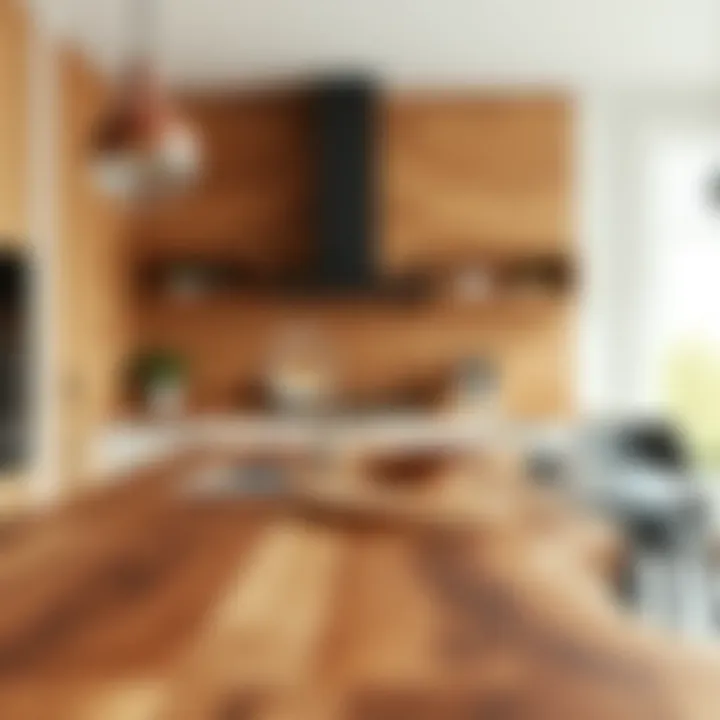
"In furniture design, the choices made in the manufacturing process can be the difference between a fleeting trend and a lasting classic."
As a conclusion to this section, understanding the nuances in manufacturing butcher block wood helps pinpoint the key aspects that contribute to the overall performance and look of the finished product. The options of glued versus laminated, the difference between end grain and edge grain — these factors are not just technical terms but vital choices that impact how the material fits into the home and lifestyle.
Advantages of Using Butcher Block Wood
When it comes to furniture design, butcher block wood is more than just a practical choice; it embodies a blend of functional benefits and aesthetic charm. The appeal of utilizing butcher block in designing furniture can’t be understated, especially for homeowners and designers who seek to harmonize utility with beauty. This section dives into several advantages that butcher block wood brings to the table: its aesthetic appeal, durability and longevity, and versatility across various applications.
Aesthetic Appeal
Butcher block wood exudes a warmth and familiarity that many find irresistible. The natural grains, colors, and textures present in different wood types—like maple and walnut—create a unique character in each piece of furniture. Using butcher block adds a rustic charm that can resonate with both modern and traditional interiors, bridging the gap between the two styles.
Moreover, the craftsmanship involved in creating butcher block surfaces often showcases intricate designs that enhance visual interest. For instance, the patterned blocks can be arranged in various configurations, allowing designers to play with aesthetics. It’s this capacity for personalized expression that makes butcher block wood a popular choice for creating statement pieces in living spaces.
Durability and Longevity
Durability is another key advantage. Butcher block wood is renowned for its ability to withstand daily wear and tear. Unlike many synthetic materials, wood possesses intrinsic resilience that allows it to endure the hustle of everyday life. Properly cared for, butcher block can last a lifetime, which is a fantastic investment for homeowners.
In terms of longevity, butcher block naturally ages well. Over time, it develops a rich patina, adding to its charm, rather than detracting from it. Homeowners who prefer the look of aged wood often find themselves drawn to butcher block furnishings as they morph and mature. This can yield a living history in one’s home.
Versatility in Applications
Butcher block wood’s versatility has made it a go-to material for a variety of furniture types.
Counters
When considering counters, butcher block stands out as a beautiful and practical choice for kitchens and bathrooms. The warm tones of the wood not only add coziness but also provide a durable surface for food prep and daily tasks. The uniqueness of wood grains means that no two countertops are the same, offering a bespoke element in any kitchen. However, ongoing maintenance—such as regular oiling—can sometimes be seen as a disadvantage, but the payoff is worth it for many.
Tables
Butcher block tables carry a sense of stability and warmth that feels inviting, perfect for gathering friends and family. The solid construction ensures that these tables can handle everything from intimate dinners to rambunctious game nights. The key characteristic of butcher block tables lies in their ability to be refinished, providing owners with the chance to rejuvenate their furniture rather than replace it. This could be considered a hassle for some, but for many, it’s a welcome opportunity to preserve family heirlooms.
Shelving
Shelving made from butcher block wood showcases robustness while also acting as an aesthetic feature in a room. The strength of this wood allows for shelves to bear significant weight without bowing or sagging. Additionally, the visual impact that butcher block shelves make can transform simple storage units into stunning focal points. The downside, however, is that wooden shelves need the right environment to avoid warping from humidity. Nevertheless, the benefits often outweigh this minor inconvenience.
In summary, the advantages of using butcher block wood stretch far beyond mere functionality; they encapsulate beauty, durability, and adaptability that are hard to find in many other materials.
Disadvantages of Butcher Block Wood
While butcher block wood has garnered acclaim for its stunning grain patterns and durability, it’s essential for homeowners, designers, and DIY enthusiasts to understand its drawbacks. Considering the cons of this material is crucial to make informed choices in furniture design and usage, ensuring that the aesthetic appeal aligns with practical demands.
Maintenance Requirements
One of the prominent disadvantages of butcher block wood is the maintenance it requires. Unlike some other materials that thrive on neglect, butcher block needs a little extra TLC to keep it looking sharp and pristine. Here are a few key points worth mentioning:
- Regular Cleaning: It’s not enough to simply wipe down the surface with a damp cloth. You need to use mild soap and water to maintain its beauty and prevent the buildup of bacteria.
- Avoiding Moisture: Constant exposure to water can lead to warping or even mold growth, which is a nightmare to deal with. So, it’s critical to dry surfaces thoroughly after cleaning.
- Periodical Oiling: Just like a beloved leather jacket that needs conditioning, butcher block wood must be oiled to keep it hydrated and to protect it from splits and stains. This should generally be done every few months, depending on usage.
These maintenance tasks can feel like a chore, especially for those who lead busy lives. It seems that with butcher block, beauty doesn't come without commitment.
Susceptibility to Damage
Butcher block wood is not without vulnerabilities. While it stands up strong against everyday challenges, it does have some specific susceptibilities that are worth noting:
- Nicks and Scratches: With knives and other kitchen tools dancing across its surface, butcher block wood is prone to scratches and nicks. While these marks can sometimes add character, they can also compromise the surface if left untreated.
- Heat Sensitivity: Placing hot pots or pans directly on the surface can lead to unsightly scorch marks or warping. Always use trivets or hot pads if you want your butcher block to stand the test of time.
- Chemical Sensitivity: Harsh cleaning chemicals can strip away the protective layer of oil, potentially leaving the wood exposed to damage. It’s crucial to stick to gentle cleansers to preserve the integrity of the material.
"A beautiful piece of butcher block wood is often only as good as the care it receives. Like any fine craftsmanship, it requires appropriate attention to flourish and thrive."
Maintaining a good balance between beauty and practicality is key in any design consideration.
Care and Maintenance
Understanding proper care and maintenance of butcher block wood is essential for those who appreciate this material's unique qualities in furniture design. While butcher block has a reputation for being durable and long-lasting, it does require certain upkeep to preserve its integrity and beauty over time. Regular care not only extends the life of your furniture but also enhances its aesthetic appeal and functionality.
Cleaning Practices
Keeping butcher block wood clean is not just a matter of aesthetics; it’s crucial for maintaining its condition. Unlike some materials, butcher block can be sensitive to certain cleaning methods, so it helps to be informed on how to do this right.
- Frequency: Regular cleaning after each use can prevent the build-up of dirt and stains. For instance, after chopping vegetables, it’s a good practice to wipe down the surface with a damp cloth.
- Cleaning Solutions: Use a mild soap solution or a mix of vinegar and water. This helps in removing bacteria without overly saturating the wood.
- Avoid Harsh Chemicals: Steer clear of bleach or ammonia-based cleaners, as they can damage the finish and the wood itself. Instead, opt for natural cleaning agents that are gentle yet effective.
An important tip here is to always remember to dry the surface fully after cleaning to prevent moisture from seeping into the wood. A dry butcher block is a happy butcher block.

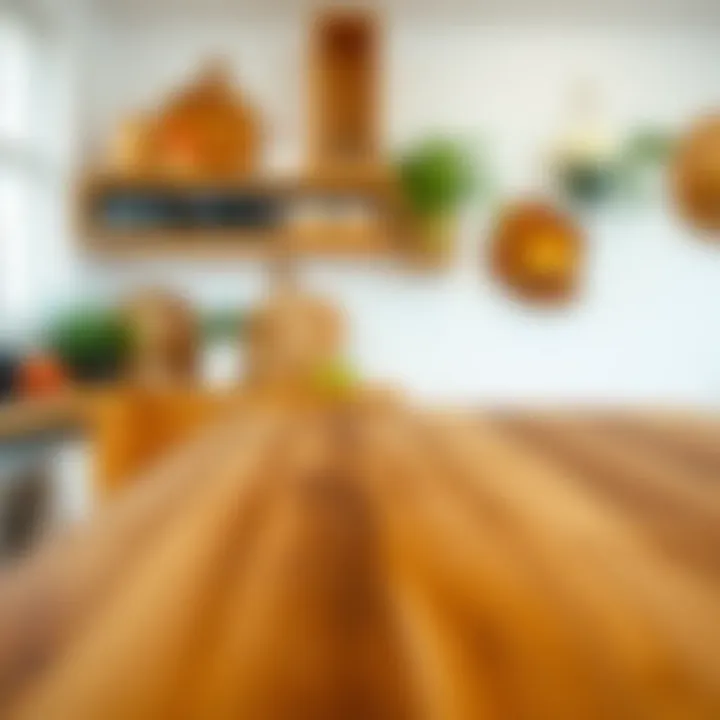
Oiling and Sealing
Oiling and sealing go hand-in-hand when it comes to maintaining butcher block furniture. Without adequate oil, the wood can dry out, leading to cracks and splitting.
- Why Oil?: Regular oiling helps to maintain the wood's moisture and shine. It also acts as a barrier against stains and water damage.
- Recommended Oils: Food-safe mineral oil is a popular choice, while some people prefer tung oil for its water-resistant properties. The key is to avoid vegetable oils as they can turn rancid and lead to unpleasant odors.
- How to Apply: Apply a generous amount of oil using a clean, soft cloth. It’s best to apply oil in a circular motion to ensure even coverage. Allow it to soak for a few hours or overnight, and then buff off any excess.
Sealing the butcher block is another layer of protection. A high-quality finish, like a polyurethane or a specially designed butcher block finish, can provide an added barrier against moisture and wear. It’s advisable to reseal your butcher block every few years, or when the surface begins to look dull.
"Regular maintenance not only preserves the beauty of your butcher block but also its utility in daily life."
By incorporating these care and maintenance practices, homeowners, designers, and DIY enthusiasts can enjoy their butcher block furniture for many years to come. Good maintenance is key to ensuring that this beautiful wood continues to serve its purpose while keeping its attractive appearance intact.
Environmental Considerations
In the realm of furniture design, the spotlight shines brightly on environmental considerations. More than just a fleeting trend, the commitment to sustainable practices has become paramount. Embracing butcher block wood, with its unique qualities, opens up important discussions about how our choices impact the planet. This section aims to shed light on sustainability, the sourcing of wood, and the effects these practices have on ecosystems.
Sustainability of Wood Sources
Sustainable sourcing is at the crux of any eco-friendly furniture design. Butcher block wood, particularly when sourced responsibly, can significantly reduce the environmental footprint of furniture production. Many manufacturers today are leaning towards practices that promote the health of forests and their ecosystems.
To ensure sustainability, several key elements must be considered:
- Certification: Selecting wood products certified by organizations such as the Forest Stewardship Council (FSC) assures consumers that the wood comes from responsibly managed forests. This means that for every tree cut down, more trees are planted.
- Recycled Wood: Utilizing reclaimed wood not only minimizes waste but also reduces the demand for new timber. This practice not only saves trees but also gives a new life to materials often discarded.
- Local Sourcing: Opting for locally sourced butcher block wood diminishes transportation emissions. Local woods are often well-suited to their environments, providing durability and strengthening community ties.
Embracing these practices not only brands a furniture line as sustainable but, more crucially, contributes to the conservation of our planet's valuable resources.
Impact on Ecosystems
The implications of wood sourcing extend far beyond mere aesthetics; they reach deep into ecological territory. Unsustainable practices can lead to deforestation, which in turn destabilizes local ecosystems and endangers various species. Each tree felled without careful consideration can disrupt habitats crucial for countless organisms.
A few significant repercussions of poor wood sourcing practices include:
- Loss of Biodiversity: When vast areas of forest are cleared, the delicate balance of species is disrupted. Many plants and animals can face extinction when they lose their natural habitat.
- Soil Erosion: Trees play a vital role in maintaining soil integrity. When forests are removed, the soil can erode, leading to loss of fertile land and increased sediment in waterways, which detrimentally affects aquatic life.
- Climate Change: Trees are critical for carbon sequestration. Their removal not only releases stored carbon but also diminishes the planet’s capacity to absorb carbon dioxide, intensifying the challenge of climate change.
"Taking care of our forests is like taking care of our planet’s lungs; each tree stands as a guardian of a balanced ecosystem."
By understanding the far-reaching consequences of wood sourcing, designers, homeowners, and DIY enthusiasts can make informed decisions that prioritize the health of the planet. It’s not just about choosing butcher block wood for its beauty but recognizing that each piece carries an environmental responsibility.
Through conscious efforts towards sustainable practices, the furniture industry can contribute to a greener future while still celebrating the beauty and functionality of butcher block wood.
Trends in Butcher Block Wood Design
The landscape of furniture design is always shifting, and butcher block wood is no exception to this evolving trend. In recent years, it has emerged from its humble origins to become a sought-after material among homeowners and designers alike. The trending focus on incorporating natural materials, sustainable practices, and personalized aesthetics positions butcher block wood right in the crosshairs of modern design interests. Moreover, the versatility of this material allows for creative expression in various furniture applications, making it a hot topic worth analyzing.
Modern Aesthetic Integrations
In the world of contemporary design, butcher block wood is increasingly being integrated into modern aesthetics. This type of wood brings an earthy, warm quality that complements minimalist and industrial styles. Designers often showcase its natural grain patterns, allowing them to add character and depth to pieces while staying true to clean lines. The beauty of butcher block lies not only in its visual appeal but also in its tactile satisfaction. It invites interaction and creates a connection between the user and the furniture.
When attempting to find a balance between harsh modern materials and soft natural elements, butcher block is a prime choice. Many furniture makers now customize butcher block elements within sleek metal or glass frames, creating juxtaposition without sacrificing cohesiveness. Each piece tells a unique story, influenced by the wood itself. For instance, a coffee table with a butcher block top not only provides function but serves as a conversation starter, drawing attention to its unique grain and finish.
"Natural patterns in butcher block wood serve as reminders of nature's artistry, enhancing the home while providing a warmth unmatched by synthetic materials."
Innovative Uses in Furniture
The traditional image of butcher block, often tied to kitchen counters, is evolving. Today, this wood is making waves across various furniture categories, finding its place in unexpected areas. Designers are getting creative, using butcher block in ways that extend far beyond the kitchen.
- Dining Tables: Many now feature extensive butcher block surfaces that offer not only sturdiness but also a classic style that never goes out of fashion.
- Shelving Solutions: Utilizing butcher block for shelving adds a robust character. It can support heavy books while maintaining an inviting visual appearance, often becoming the focal point of a room.
- Desk Designs: With the rise of remote work, many people are searching for inspiring home office setups. Butcher block desks provide vast workspaces while radiating a warmth that encourages productivity.
- Accent Pieces: From end tables to storage boxes, smaller items are emerging that utilize butcher block as a primary material. This idea pairs functionality with art, elevating basic furniture to something extraordinary.
As we push the boundaries of design, butcher block wood continues to surprise, providing timeless versatility infused with natural beauty. For homeowners, designers, and DIY enthusiasts alike, exploring these trends could open doors to new heights in creativity and style while crafting spaces that are genuinely reflective of individual taste.
Closure
When it comes to furniture design, butcher block wood stands out as an enduring choice with both practicality and style. This conclusion wraps up key insights from our exploration of this versatile material, emphasizing several crucial elements, benefits, and considerations that every homeowner, designer, and DIY enthusiast should take into account.
The Importance of Butcher Block Wood
Butcher block wood is more than just a functional surface; it serves as a statement piece in any home. Its natural beauty, characterized by rich grain patterns and warm tones, adds a layer of visual appeal that enhances a space. When selecting butcher block wood, it’s essential to consider not only its aesthetic value but also how it fits into one’s lifestyle and needs.
Benefits of Incorporating Butcher Block
One of the standout advantages is its durability. A well-maintained butcher block can withstand the test of time, resisting scratches and cuts better than many alternatives. Additionally, it is relatively easy to repair—nicks can be sanded down, and oils can refresh its appearance. Moreover, this wood has the unique quality of being self-healing; the natural fibers can close up after cuts, ensuring a clean surface after regular use.
Sustainable Design Considerations
As we think about the future, sustainability remains a critical consideration. Consumers today are increasingly aware of their environmental footprint. Fortunately, many butcher block wood sources prioritize sustainable practices. This can mean opting for FSC-certified woods or exploring local sources that minimize transportation emissions.
"Choosing materials wisely not only benefits your home but also the environment it inhabits."
Emerging Trends to Watch
The world of design is ever-changing, and butcher block wood is no exception. Homeowners and designers are finding innovative ways to integrate this material into contemporary aesthetics. From open shelving in kitchens to statement dining tables, the applications are nearly limitless. Unique combinations with metals or glass are also becoming more popular, creating a striking contrast that appeals to modern sensibilities.
The Future of Butcher Block Wood
In looking ahead, butcher block wood will likely continue evolving. Designers may experiment with new styles, finishes, and techniques, pushing the boundaries of traditional uses. Innovations, such as moisture-resistant treatments and integrated technology for smart homes, could redefine how we think about and use this remarkable material. Additionally, as environmental awareness grows, the call for sustainably sourced butcher block wood will only amplify, encouraging an industry shift toward more eco-conscious practices.















